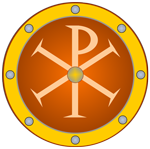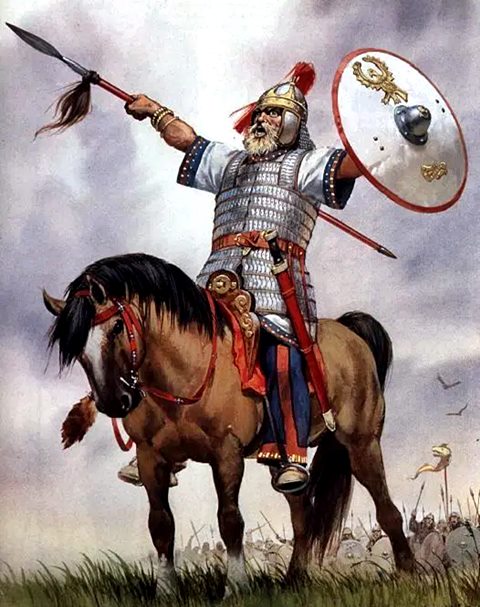
Battle of Faventia |
year: 542 |
| Defeat of the Byzantine army of Italy by the Ostrogoths | ★ ★ ★ ★ ★ |
|
enemy: Ostrogoths
|
location: Near the town Faventia (modern Faenza in Emilia-Romania, SE of Bologna in central Italy)
|
accuracy:
●●●●●
|
|
battle type: Pitched battle |
war: Gothic War in Italy |
modern country:
Italy |
| ▼ The Byzantines(emperor: Justinian I) | ▼ The Enemies | |
| Commander: | Constantinianus, Alexandros | King Totila |
| Forces: | 12,000 | 5,000 |
| Losses: |
| Background story: |
| In May 540, after the capture of Ravenna by Belisarius, the Ostrogothic kingdom of Italy collapsed and the Gothic War was over. Only it wasn’t. Yes, the Byzantines had prevailed in most of Italy, but there were several areas in the north that had not surrendered. The important cities of Ticinum (modern-day Pavia) and Verona remained under Ostrogothic control, and this control soon extended to all of northern Italy north of the Po River. Their king Vitiges was taken prisoner in Constantinople, but the Goths had no problem electing another in his place, first Ildivad and then an Herul, Erarich. Erarich began negotiations with Constantinople for the full subordination of his kingdom to the Byzantine Empire. These talks did not proceed because in 542 he was assassinated and Totila ascended the throne of the Ostrogoths. Belisarius had left for Constantinople after Ravenna but was not replaced. In Italy there was no one now in command of the army. Of the various generals who until then had been under Belisarius, each took on an important city as governor. Emperor Justinian had sent a bureaucrat to Ravenna, the logothetes Alexandros, nicknamed “Scissors”, who had taken over the finances and was hated by all – both the military and the local population –while he himself quickly became rich. The assassination of Erarich infuriated Justinian who blamed the commanders of the army in Italy for loosing the opportunity for full supremacy on the Italian peninsula. The generals gathered in Ravenna to decide on their next moves. The decision was to immediately attack Verona, which was the new informal capital of the Ostrogoths. So an army of 12,000 men, led by the lords of Ravenna Constantinianus and Alexandros, assembled and marched against Verona. The other eleven Byzantine generals of Italy also took part in the operation. The Byzantine army arrived very quickly in Verona. One of the guards was bribed and opened the gates to them at night. The generals were afraid to enter the city, perhaps because they feared it was a trap. Instead, they chose to be preceded by a reconnaissance team. This mission was undertaken by an Armenian officer, Artavazes, who selected 100 men and entered the city. This detachment killed the guards and occupied the walls. The Goths of Verona, when they realized that the enemies had entered the city, hurried to leave it overnight. But they did not go far, waiting a little further out to see how things would go. The next morning, the main body of the Byzantine army, which had encamped 5-6 km away from Verona, did not show much haste to come to the city to secure its occupation. The reason for this delay was the disagreements that arose between the generals over how the spoils of Verona would be distributed! Some of the Ostrogoths who had stayed in the towers and had an overview of the situation, saw in the light of day that the Byzantines in the city were very few, so they notified their compatriots who came back. When the rest of the Byzantine army set out for Verona, it found the gates closed and the Goths on the ramparts. Artavazes’ men, who had been stranded in the city, began to jump from the high walls to escape, and many of them were killed or wounded in the attempt. |
The Battle: |
 Vualaris The leaders of the Byzantines again remained inactive and made no move to prevent the Goths from crossing the river and so Totilas’ army crossed the Po undisturbed and headed for Faventia. The leader of the Ostrogoths correctly recognized that the power vacuum in the Byzantine army and the personal rivalries between the Byzantine generals presented a unique opportunity. A victory at this moment would secure him on the throne and would motivate the rest of the Goths of Italy to follow him against the Byzantines. Approaching Faventia, Totila sent 300 of his men to sneak behind the Byzantine army to attack their rear at the right time. When the two armies lined up for battle, a huge Goth named Vualaris rode his horse forward and began to provoke the Byzantines to fight with him. The only one who dared was Artavazis. After a short duel, Artavazis moved faster and hit the Goth with his spear on the right side. The spear pierced him and was nailed to the ground, while Vualaris remained in a strange position almost standing, but dead. Artavazis bent down to get his spear and then, as he pulled it sharply, he fell on theGoth's spear which had remained in a vertical position and which slightly injured his neck. At that moment, Artavazis almost did not realize that he had been wounded, but he started bleeding inside his armor. With the end of the duel, the battle began. At some point, the 300 Goths appeared behind the Byzantines, who were taken by surprise and, thinking that they were surrounded by a large army, panicked. The battle ended there. The Byzantines began to retreat erratically under the pressure of the Ostrogoths who inflicted many losses on them. Totila did not have enough men to insist on their pursuit, but at the end of the day many prisoners and all the Roman banners had fallen into his hands. The Byzantine army was dispersed and each of the generals took refuge in his city. Artavazis died from his injury three days later. |
Aftermath: |
| It was the first great victory of Totila and the beginning of a series of military successes that in a short time led to the almost complete recapture of Italy by the Ostrogoths. Totila did not rest and, wanting to take advantage of the momentum, besieged Florence. |
|
|
